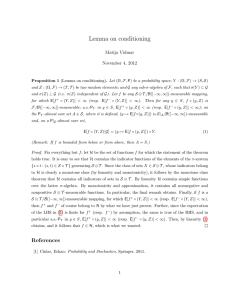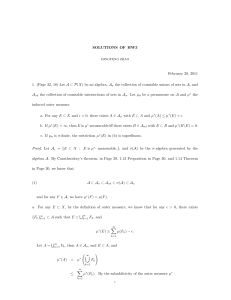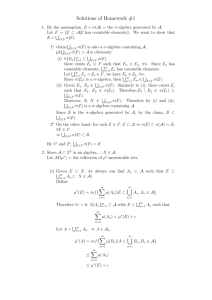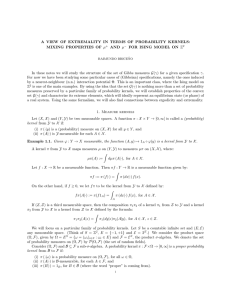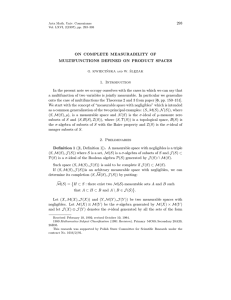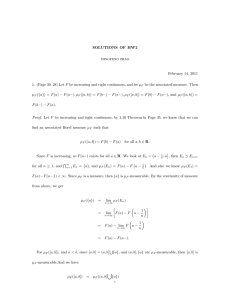Stat 643 Spring 2010 Assignment 04
advertisement
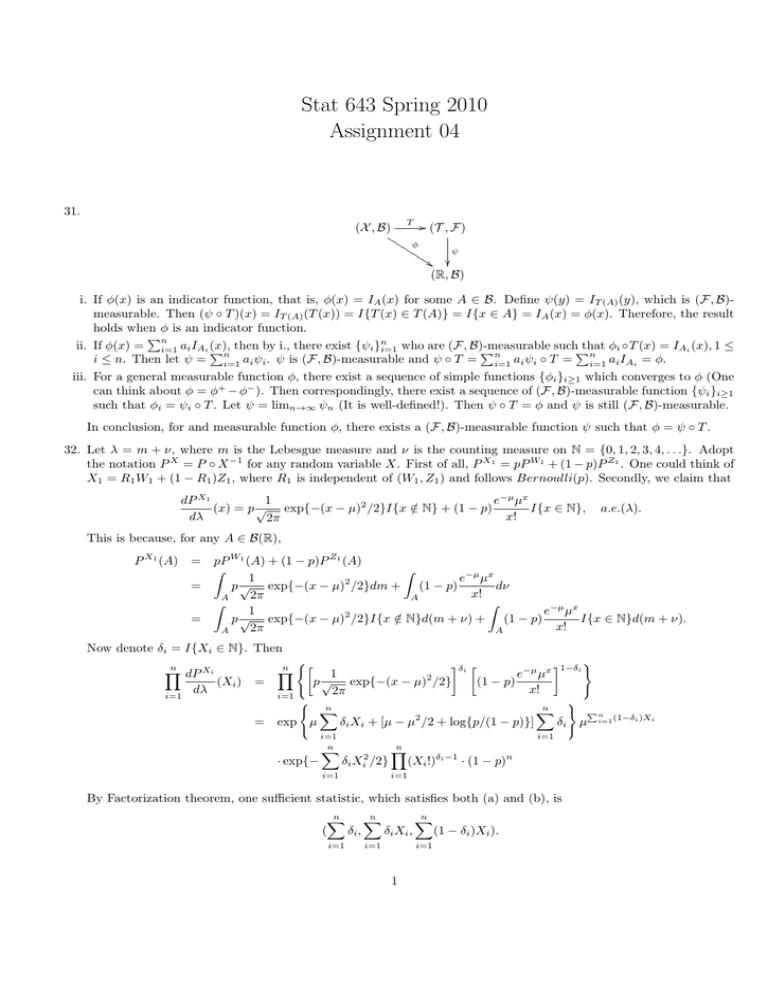
Stat 643 Spring 2010
Assignment 04
31.
/ (T , F)
(X , B)
II
II φ
II
ψ
II
I$ (R, B)
T
i. If φ(x) is an indicator function, that is, φ(x) = IA (x) for some A ∈ B. Define ψ(y) = IT (A) (y), which is (F, B)measurable. Then (ψ ◦ T )(x) = IT (A) (T (x)) = I{T (x) ∈ T (A)} = I{x ∈ A} = IA (x) = φ(x). Therefore, the result
holds when φ is an indicator function.
Pn
n
ii. If φ(x) = i=1 ai IAi (x),
suchP
that φi ◦T (x) = IAi (x), 1 ≤
Pn then by i., there exist {ψi }i=1 who are (F, B)-measurable
Pn
n
i ≤ n. Then let ψ = i=1 ai ψi . ψ is (F, B)-measurable and ψ ◦ T = i=1 ai ψi ◦ T = i=1 ai IAi = φ.
iii. For a general measurable function φ, there exist a sequence of simple functions {φi }i≥1 which converges to φ (One
can think about φ = φ+ − φ− ). Then correspondingly, there exist a sequence of (F, B)-measurable function {ψi }i≥1
such that φi = ψi ◦ T . Let ψ = limn→∞ ψn (It is well-defined!). Then ψ ◦ T = φ and ψ is still (F, B)-measurable.
In conclusion, for and measurable function φ, there exists a (F, B)-measurable function ψ such that φ = ψ ◦ T .
32. Let λ = m + ν, where m is the Lebesgue measure and ν is the counting measure on N = {0, 1, 2, 3, 4, . . .}. Adopt
the notation P X = P ◦ X −1 for any random variable X. First of all, P X1 = pP W1 + (1 − p)P Z1 . One could think of
X1 = R1 W1 + (1 − R1 )Z1 , where R1 is independent of (W1 , Z1 ) and follows Bernoulli(p). Secondly, we claim that
1
e−µ µx
dP X1
(x) = p √ exp{−(x − µ)2 /2}I{x ∈
/ N} + (1 − p)
I{x ∈ N},
dλ
x!
2π
a.e.(λ).
This is because, for any A ∈ B(R),
P X1 (A)
=
=
=
pP W1 (A) + (1 − p)P Z1 (A)
Z
Z
e−µ µx
1
dν
p √ exp{−(x − µ)2 /2}dm + (1 − p)
x!
2π
A
A
Z
Z
1
e−µ µx
p √ exp{−(x − µ)2 /2}I{x ∈
/ N}d(m + ν) + (1 − p)
I{x ∈ N}d(m + ν).
x!
2π
A
A
Now denote δi = I{Xi ∈ N}. Then
(
)
δi n
−µ x 1−δi
Y
1
e
µ
p √ exp{−(x − µ)2 /2}
(Xi ) =
(1 − p)
dλ
x!
2π
i=1
( n
)
n
X
X
Pn
2
= exp µ
δi Xi + [µ − µ /2 + log{p/(1 − p)}]
δi µ i=1 (1−δi )Xi
n
Y
dP Xi
i=1
· exp{−
i=1
n
X
i=1
δi Xi2 /2}
i=1
n
Y
(Xi !)δi −1 · (1 − p)n
i=1
By Factorization theorem, one sufficient statistic, which satisfies both (a) and (b), is
(
n
X
i=1
δi ,
n
X
δi Xi ,
i=1
n
X
i=1
1
(1 − δi )Xi ).
33. The Pθ in this context really means PθX , that is, PθX ({x}) = (1 − p)px−θ I{x − θ ∈ N}, where N shares the same
definition as in Problem 32.
(a) Suppose Pθ can be dominated by some σ-finite measure µ, then Pθ must be dominated by a probability measure λ
(Lemma 52). As PθX ({θ}) = 1−p > 0 for all θ, this means λ({θ}) > 0 for all θ. This is not possible for a probability
measure λ. Specifically, let D0 = {x ∈ R | λ({x}) > 1}, Dn = {x ∈ R | 1/(n + 1) < λ({x}) ≤ 1/n}, n ≥ 1. Then
R = ∪n≥0 Dn . This means, there exists uncountable set Dn0 . From the construction of Dn0 we know that
λ(Dn0 ) = ∞ as it contains infinitely many points.
(b) Consider PP
(X1 = x1 , . . . , Xn = xn |X(1) = t1 , Sn = t2 ), where X(1) is the minimum order statistic of X1 , . . . , Xn
n
and Sn = i=1 Xi . We would assume that t1 > θ, since otherwise
Pn the conditioning set is empty. Secondly, this
probability would be 0, if (x1 , . . . , xn ) ∈
/ E(t1 , t2 ) = {(k1 , . . . , kn )| i=1 ki = t2 , min1≤i≤n ki = t1 , ki − θ ∈ N}. Thus
P (X1 = x1 , . . . , Xn = xn , X(1) = t1 , Sn = t2 ) = (1 − p)n pt2 −nθ I{(x1 , . . . , xn ) ∈ E(t1 , t2 )}. Furthermore, P (X(1) =
P
P
t1 , Sn = t2 ) = (k1 ,...,kn )∈E(t1 ,t2 ) P (X1 = k1 , . . . , Xn = kn ) = (k1 ,...,kn )∈E(t1 ,t2 ) (1 − p)n pt2 −nθ . Consequently,
P (X1 = x1 , . . . , Xn = xn |X(1) =
Ptn1 , Sn = t2 ) = 1/|E(t1 , t2 )|, where |E(t1 , t2 )| is the size of E(t1 , t2 ). Notice further
that
E(t
,
t
)
=
{(k
,
.
.
.
,
k
)
|
1
2
1
n
i=1 (ki −t1 ) = t2 −nt1 , ki −t1 ∈ N, min1≤i≤n (ki −t1 ) = 0} = {(r1 +t1 , . . . , rn +tn ) |
Pn
r
=
t
−
nt
,
r
∈
N,
min
ri = 0}, which implies that it is independent of θ and only depends on t1 , t2 .
i
2
1
i
1≤i≤n
i=1
Thus (X(1) , Sn ) is sufficient for {Pθ }θ∈Θ .
(c) When θ is known, Θ = (0, 1) and PθX is dominated by counting measure ν, with R-N derivative
dPθX
(x) = (1 − p)px−θ I{x − θ ∈ N}, a.e.(ν).
dν
By factorization theorem,
P
i
Xi would be a sufficient statistic.
34. First we claim that
σ(T ) = {C ∈ B k | π(C) = C, ∀π}.
This is because permutation on x ∈ Rk would not change the order of it, that is, T (π(x)) = T (x), ∀π. This suggests
that the collection of σ(T )-measurable functions is
{f : Rk → R | f is a measurable function and f ◦ π = f, ∀π}
P
0
Now consider Y (x) =
σ(T )-measurable as Y ◦
π Iπ(B) (x)/k!, where x = (x1 , . . . , xk ) .P First of all, Y (X) is P
π(x)
=
Y
(x),
∀π.
Secondly,
for
any
C
∈
σ(T
),
E(I
Y
(X))
=
P
(π(B)
∩
C)/k!
=
B
π
π P (π(B) ∩ π(C)/k! =
P
P
P
(π(B
∩
C))/k!
=
P
(B
∩
C)/k!
=
P
(B
∩
C)
=
E(I
I
).
Therefore,
P
(B|σ(T
))
=
Y
(X),
a.s.(P ). Note that
B
C
π
π
P
Y (x) = π IB (π(x))/k! as well.
2
